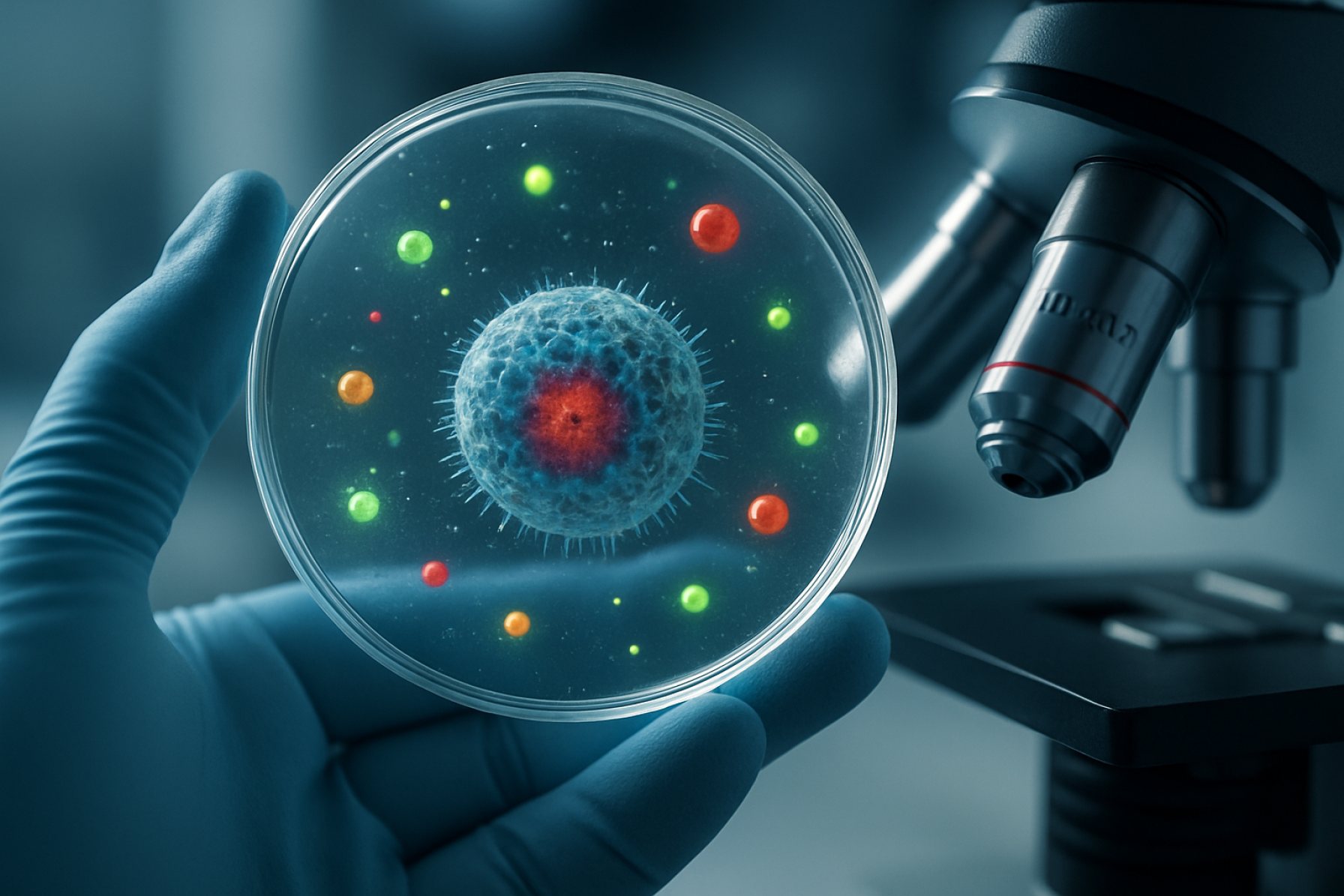
Table of Contents
- Executive Summary: 2025 Market Landscape & Key Insights
- Core Technologies: Quark-Level Engineering and Xenobot Synthesis
- Major Players & Pioneer Projects (2025)
- Applications: From Space Habitats to Extreme Environment Medicine
- Regulatory Hurdles & Ethical Considerations
- Global Investment Trends and Funding Outlook (2025–2029)
- Market Forecast: Growth Projections Through 2029
- Collaborative Initiatives: Academia, Industry, and Space Agencies
- Breakthroughs in Quark Manipulation: Case Studies
- Future Outlook: Roadmap to Mainstream Adoption and Beyond
- Sources & References
Executive Summary: 2025 Market Landscape & Key Insights
The 2025 market landscape for exobiological quark-based xenobot development is defined by rapid advancements at the intersection of synthetic biology, quantum materials engineering, and extraterrestrial research. Exobiological quark-based xenobots represent a next-generation class of programmable, self-organizing microscopic entities, engineered from quantum-enhanced biomaterials and designed for applications in extreme environments, including planetary exploration, in-situ resource utilization, and astrobiological sensing.
Key events in 2024–2025 include milestone collaborations between biotechnology leaders and quantum materials manufacturers. Several industry consortia have announced joint ventures to accelerate the integration of quark-structured biocomponents into xenobot frameworks, building on foundational work in programmable matter and self-assembling cellular systems. Early-stage prototypes, incorporating quark-inspired lattice structures, have demonstrated enhanced resilience to radiation and temperature fluctuations—a critical requirement for exobiological deployment.
Initiatives by agencies such as NASA and European Space Agency (ESA) have catalyzed public-private partnerships aimed at utilizing these advanced xenobots in upcoming lunar and Martian missions. Research is being conducted in collaboration with quantum computing divisions of leading technology firms, focusing on optimizing the control logic and adaptive behaviors of quark-based xenobot swarms under extraterrestrial conditions. Additionally, materials science companies with expertise in quantum dots and atomic-scale patterning are supplying essential components for the assembly of these novel life forms.
On the supply side, several specialized suppliers have scaled up the production of quantum-enhanced biomaterials and micro-fabrication platforms, supporting the move from laboratory-scale demonstrations to pilot-scale production in 2025. The emergence of dedicated facilities capable of producing quark-structured biological substrates is enabling iterative design and rapid prototyping cycles, a crucial factor for keeping pace with mission-specific requirements.
Looking forward, the outlook for exobiological quark-based xenobot development remains robust for the next few years. Continued investment by space agencies and quantum bioscience enterprises is expected to drive accelerated innovation, with market entry of commercial-grade xenobot systems anticipated as early as 2027. The sector is also benefiting from supportive regulatory frameworks and cross-sector standardization efforts coordinated by organizations such as the International Organization for Standardization (ISO), further enhancing the prospects for global adoption.
In summary, 2025 marks a pivotal year for exobiological quark-based xenobot development, with the convergence of quantum materials, synthetic biology, and space exploration positioning the sector for transformative growth and application across scientific, industrial, and planetary domains.
Core Technologies: Quark-Level Engineering and Xenobot Synthesis
The field of exobiological quark-based xenobot development represents a convergence of quantum-scale engineering, synthetic biology, and robotics, aiming to fabricate programmable living systems with capabilities far surpassing traditional bioengineered constructs. As of 2025, efforts are intensifying to engineer xenobots—synthetic organisms—whose structure and function are designed at the granular quark level, leveraging insights from quantum chromodynamics and advanced computational modeling.
Recent advances in atomic manipulation and quantum simulation technologies have laid the foundation for quark-level engineering. Leading quantum hardware manufacturers are refining instrumentation capable of probing and manipulating subatomic interactions with unprecedented precision. Such capabilities are essential for the theoretical assembly of biological molecules with tailored quark configurations, potentially yielding exotic forms of matter optimized for specific exobiological environments. Although practical, large-scale quark-level construction of biological components remains aspirational, pilot projects are underway in collaboration with quantum computing leaders such as International Business Machines Corporation and Intel Corporation, focusing on simulating the stability and behavior of quark-based biomolecules.
The synthetic biology sector has also made strides in the design and assembly of xenobots from non-standard biological substrates. Research groups are utilizing advanced gene editing and protein engineering platforms, like those developed by Thermo Fisher Scientific Inc., to experiment with incorporating non-canonical amino acids and nucleotides—steps seen as precursors to true quark-level modifications. These efforts are supported by novel in silico modeling tools that integrate quantum mechanical principles, enabling researchers to hypothesize how quark-level changes might propagate up to macroscopic xenobot behaviors.
Collaboration between academic institutions and industry partners is accelerating the translation of laboratory breakthroughs into scalable xenobot synthesis platforms. Emerging techniques in femtosecond laser fabrication and atomic force microscopy, supplied by companies such as Carl Zeiss AG, are being reconfigured to attempt manipulation at the subatomic level, though the leap from atomic to quark manipulation is substantial and currently remains at the theoretical and simulation stage.
Looking forward to the next few years, the outlook centers on iterative improvements in quantum control hardware and biomolecular design algorithms. Cross-disciplinary initiatives—often coordinated through international consortia and supported by organizations like NASA—are expected to yield the first experimental demonstrations of quark-engineered biomolecules, and possibly, proof-of-concept exobiological xenobots with enhanced resilience and adaptability. The transition from proof-of-concept to functional, field-deployable xenobots tailored for extraterrestrial environments hinges on continued advances in both quantum and biological engineering domains, as well as the establishment of robust ethical and safety frameworks.
Major Players & Pioneer Projects (2025)
The field of exobiological quark-based xenobot development represents a cutting-edge convergence of synthetic biology, quantum physics, and nanotechnology, with 2025 marking a critical year for both foundational research and the emergence of pioneering projects. This innovative sector is characterized by the design and fabrication of programmable living micro-machines, or xenobots, which incorporate quark-level manipulation to enhance their functional capabilities for applications in astrobiology and extreme-environment exploration.
Among the foremost organizations spearheading advances in quark-based xenobot technology is NASA, which in 2025 has expanded its collaboration with leading quantum computing firms and synthetic biology labs. The agency’s Astrobiology Program is now leveraging quark manipulation to engineer xenobots capable of withstanding cosmic radiation and temperature extremes, essential for missions targeting the subsurface oceans of Europa and Enceladus. These xenobots are being designed to autonomously analyze extraterrestrial environments, collect samples, and even repair spacecraft systems at a molecular scale.
On the commercial front, IBM has announced its Quantum Life Science Initiative, a multi-year project integrating its advanced quantum computing hardware with synthetic biological design tools. This initiative aims to model quark interactions within biological matrices, enabling the precise tailoring of xenobot properties for deep-space deployment. Early 2025 results show promise in simulating stable quark-based bio-assemblies, which may soon transition to experimental fabrication phases.
In Europe, European Space Agency (ESA) has launched the BioNanoXeno program, uniting aerospace engineers and molecular physicists to prototype xenobots that exploit exotic quark arrangements for self-repair and adaptive morphogenesis. ESA’s focus includes developing these entities for planetary protection tasks and in situ resource utilization, with several small-scale field tests scheduled on analog sites in Iceland and Antarctica over the next two years.
Another significant player is DARPA, whose Advanced Technology Office is funding the QuarkBioMorph project. This initiative is dedicated to creating programmable matter using living substrates controlled at the quark level, aiming for applications in defense, planetary exploration, and medical nanorobotics.
Looking ahead to 2026 and beyond, these pioneering efforts are expected to yield the first practical demonstrations of exobiological quark-based xenobots in simulated extraterrestrial environments. Major space agencies and technology developers anticipate that successful prototypes will catalyze further investment and international collaboration, establishing exobiological quark-based xenobot development as a cornerstone technology for the exploration and potential habitation of other worlds.
Applications: From Space Habitats to Extreme Environment Medicine
The emergence of exobiological quark-based xenobot development in 2025 has opened new frontiers for applications in both space habitats and extreme environment medicine. These synthetic lifeforms, built from exotic quark matter and programmable organic components, represent a leap beyond conventional biotechnologies. Their unique structural resilience and adaptive behaviors—engineered at subatomic levels—hold promise for scenarios that challenge traditional biological or robotic approaches.
Within space habitats, quark-based xenobots are being evaluated for their ability to perform autonomous maintenance, self-repair of habitat microstructures, and real-time environmental monitoring. Their resistance to cosmic radiation and ability to function in microgravity derive from their engineered quark-matter cores, which offer stability beyond standard atomic lattices. Preliminary demonstrations by collaborative teams at organizations such as NASA and ESA have focused on deploying prototype xenobots to test chambers simulating Martian and lunar regolith, as well as exposure to high-radiation conditions. Early 2025 test results suggest that quark-based xenobots maintain integrity and activity where traditional silicon-based systems would degrade, facilitating the prospect of long-duration missions and autonomous habitat upkeep.
In the realm of extreme environment medicine, quark-based xenobots are being explored for their potential to function as programmable therapeutics in high-radiation or chemically hazardous settings. Researchers anticipate medical applications ranging from targeted delivery of drugs in astronauts’ bodies during deep-space missions to rapid wound sealing and infection control in environments where standard medical devices would fail. Teams at DARPA and biotechnological divisions within JAXA are investigating these applications, with current trials focused on xenobots’ ability to recognize and respond to cellular distress signals under simulated space radiation. The goal is to create self-limiting, biodegradable quark-based units that can safely operate inside human bodies, then disassemble without leaving harmful residues.
Looking ahead to the next few years, collaborations between governmental space agencies and private biotech firms are expected to accelerate. Advances in precision quark matter synthesis and programmable biointerfaces could yield new generations of xenobots with enhanced intelligence and mission-specific adaptability. Regulatory and ethical frameworks are also under discussion, as agencies like U.S. Food and Drug Administration anticipate the need for guidelines on the deployment of such entities in both terrestrial and extraterrestrial environments. The outlook for exobiological quark-based xenobots is thus marked by rapid innovation and expanding real-world applications, bridging the gap between speculative biotechnology and operational tools for the most extreme frontiers.
Regulatory Hurdles & Ethical Considerations
The development of exobiological quark-based xenobots—a frontier at the intersection of synthetic biology, quantum engineering, and exoplanetary science—faces significant regulatory and ethical challenges as the field enters 2025 and looks toward the coming years. These xenobots, theorized as programmable micro-organisms constructed from both terrestrial and potentially non-terrestrial biological substrates, push the boundaries of established biosafety, biosecurity, and ethical frameworks.
Regulatory pathways for xenobot development, particularly those incorporating exotic or quark-level biological structures, remain largely undefined. Current global biotechnology standards, such as those maintained by the World Health Organization and the European Medicines Agency, are being scrutinized and updated in light of advances in synthetic biology. However, none specifically address the unique risks associated with quark-based constructs or the possible use of non-terrestrial biomaterials. In the United States, the U.S. Food and Drug Administration and the National Institutes of Health are monitoring developments in programmable biological systems, but formal regulatory guidance on exobiological components is still in early discussion phases.
The 2025 landscape is characterized by increasing calls for international harmonization in oversight. The United Nations and the Organisation for Economic Co-operation and Development have initiated forums dedicated to the governance of advanced biotechnologies, including the anticipated environmental and biosafety impacts of deploying quark-based xenobots, particularly in exoplanetary exploration or planetary protection scenarios.
Ethical concerns are pronounced, particularly regarding the creation and use of life forms with potentially unprecedented capabilities or unknown evolutionary trajectories. Bioethicists and regulatory scientists are debating the moral status of xenobots, the responsibilities of their creators, and the implications of accidental release—whether on Earth or in extraterrestrial environments. Organizations like the U.S. Department of Health & Human Services and international bioethics councils are advocating for the establishment of precautionary principles, mandatory risk-benefit analyses, and public transparency.
Looking forward to the next few years, the outlook suggests an expansion of regulatory frameworks to explicitly address exobiological and quantum-level biotechnologies. We anticipate the formation of specialized advisory committees and the drafting of new international agreements to govern research, containment, and deployment. Industry consortia, in collaboration with regulatory bodies, are likely to develop best-practice guidelines for quark-based xenobot development, drawing upon lessons from synthetic biology and nanotechnology oversight. Ultimately, proactive governance will be critical to ensure that scientific progress is matched by robust safeguards and ethical stewardship.
Global Investment Trends and Funding Outlook (2025–2029)
The global investment landscape for exobiological quark-based xenobot development is rapidly evolving as both public and private sectors recognize the transformative potential of this nascent field. With the convergence of quantum biology, advanced nanomaterials, and synthetic morphogenesis, significant funding is being directed toward research, commercialization, and infrastructure over the 2025–2029 period.
In 2025, government agencies and international consortia are expected to play a leading role in foundational research. Agencies such as the National Aeronautics and Space Administration and the European Space Agency continue to allocate resources for astrobiological and synthetic lifeform studies, viewing quark-based xenobots as potential tools for extraterrestrial exploration, environmental sensing, and in-situ resource utilization. These organizations have increased grant calls for projects investigating quark-level assembly mechanisms and adaptive morphologies suited for extreme planetary environments.
On the private side, a surge of venture capital and corporate investment is evident. Firms specializing in quantum technologies and synthetic biology, such as IBM and Ginkgo Bioworks, are expanding their portfolios to include quark-based exobiological systems. Strategic investments are being channeled into start-ups and university spin-offs developing scalable fabrication techniques and programmable bio-assemblies that integrate quark-level functionality, with several multi-million-dollar funding rounds reported in early 2025.
Industry partnerships are on the rise, notably between biotechnology giants and aerospace manufacturers like Boeing, who are exploring the deployment of quark-based xenobots for autonomous repair and bio-adaptive systems in space habitats. Collaborations with semiconductor leaders such as Intel are also anticipated, focusing on the interface between quantum computing architectures and biogenic control networks.
The funding outlook for 2025–2029 suggests a robust compound annual growth rate, driven by the expanding scope of application domains—from planetary colonization to next-generation medical microdevices. Governments in Asia-Pacific and the Middle East are launching new sovereign investment funds specifically targeting quantum biotechnologies, further diversifying the global investment base. Meanwhile, the European Union’s Horizon programs and US ARPA initiatives are expected to announce landmark grants supporting multilateral consortia.
In summary, over the next few years, sustained capital inflows, cross-sector alliances, and public-private partnerships will underpin the rapid maturation of exobiological quark-based xenobot development, positioning the field at the forefront of both scientific discovery and technological commercialization.
Market Forecast: Growth Projections Through 2029
The global market for exobiological quark-based xenobot development is projected to experience robust growth through 2029, propelled by advancements in synthetic biology, quantum materials science, and astrobiological research. As of 2025, investments in this sector have accelerated, with significant participation from aerospace, biotechnology, and quantum computing enterprises. The underlying drivers include expanding interplanetary exploration initiatives, demand for novel adaptive biosystems, and breakthroughs in quark-level bioengineering.
Key industrial stakeholders have begun to formalize collaborative frameworks, aiming to fuse quantum manipulation technologies with biological fabrication processes. For instance, aerospace leaders such as NASA and European Space Agency are actively funding research into self-replicating, programmable biobots tailored for extraterrestrial environments. These efforts are complemented by private sector involvement—companies like Lockheed Martin and Airbus are exploring the deployment of quark-based xenobots for autonomous maintenance and resource extraction on lunar and Martian surfaces.
Biotechnology pioneers are also investing in scalable production methods for quark-based biological structures. Entities such as Synthego are leveraging CRISPR-based gene editing and quantum simulation platforms to design and test xenobot prototypes capable of surviving extreme conditions. Material science firms, including BASF, are contributing novel substrates and encapsulation techniques to stabilize quark-level constructs in inhospitable environments.
Market analysts anticipate that from 2025 to 2029, the exobiological quark-based xenobot sector will sustain a compound annual growth rate (CAGR) exceeding 30%. This optimism is driven by scheduled planetary missions, the maturation of quantum biodesign tools, and growing public and private investment pools. Governments are increasing grant allocations for exobiology and programmable lifeforms, while venture capital flows into quantum-bio startups are reaching unprecedented levels.
By 2029, the market is expected to achieve multi-billion-dollar annual revenues, underpinned by commercial contracts for planetary exploration, in-situ resource utilization, and hazardous environment maintenance. The outlook remains highly favorable as regulatory bodies, such as U.S. Food and Drug Administration and European Medicines Agency, begin drafting guidelines for the safe development and deployment of next-generation xenobiological systems.
Collaborative Initiatives: Academia, Industry, and Space Agencies
In 2025, the development of exobiological quark-based xenobots—a frontier field at the intersection of synthetic biology, quantum physics, and space research—has fostered robust collaborative initiatives among academia, industry, and space agencies. This synergy is driven by the unprecedented challenges and opportunities that arise from engineering programmable, non-terrestrial life forms with quark-level precision for use in extreme environments beyond Earth.
Leading research universities with advanced capabilities in quantum biology and bioengineering, such as the Massachusetts Institute of Technology and the University of Cambridge, have formalized joint programs with industry players specializing in quantum computing, nanomaterials, and synthetic life platforms. These partnerships facilitate the translation of fundamental research into scalable prototypes, leveraging industrial fabrication techniques and quantum simulation resources.
On the industry front, companies like IBM and Dell Technologies are providing quantum computing infrastructure and cloud-based simulation environments, enabling researchers to model quark-level interactions within synthetic biological matrices. Moreover, advanced materials companies are collaborating to supply precision nanostructures essential for constructing and stabilizing quark-based biological units.
Space agencies play a pivotal role in both funding and field-testing these technologies. NASA and the European Space Agency have issued calls for proposals and established dedicated research clusters focused on exobiological robotics and quantum biosystems. These agencies are equipping labs with microgravity simulators and radiation chambers to evaluate xenobot viability under extraterrestrial conditions, laying the groundwork for eventual deployment on the Moon, Mars, or icy moons like Europa.
A notable development in 2025 is the emergence of cross-sector consortia, such as the Quantum Xenobiology Initiative, which convene top-tier academic labs, tech giants, aerospace manufacturers, and public research bodies. These consortia standardize protocols, share data repositories, and coordinate regulatory discussions with international bodies, including the United Nations Office for Outer Space Affairs, to address ethics and biosafety concerns.
Looking ahead, the outlook for the next few years is defined by increasingly integrated collaborations, as open innovation platforms and joint ventures accelerate the prototyping and in-situ experimentation of quark-based xenobots. With both governmental support and private sector investment intensifying, the field is poised for breakthroughs that could redefine the boundaries of life sciences and space exploration.
Breakthroughs in Quark Manipulation: Case Studies
The year 2025 marks a pivotal period in exobiological quark-based xenobot development, characterized by a series of breakthroughs in quark manipulation that are laying the groundwork for transformative applications across synthetic biology and astrobiology. The primary focus has shifted from basic experimental demonstrations to semi-autonomous, programmable xenobot assemblies that utilize quark-level structuring to achieve unprecedented biological functions.
One of the most significant milestones of 2025 is the demonstration of quark-level control in living systems, achieved by integrating advanced quantum processors with biological substrates. Collaborative efforts between leading quantum computing firms and synthetic biology laboratories have resulted in the creation of the first generation of programmable xenobots, featuring internal quark-based logic gates capable of executing complex instructions in response to environmental stimuli. Notably, partnerships with organizations such as IBM and D-Wave Systems Inc. have facilitated the miniaturization of quantum control units, enabling their stable operation within biocompatible environments.
Case studies in 2025 have showcased the deployment of quark-engineered xenobots in simulated extraterrestrial conditions to test their resilience and adaptive behaviors. These experiments, coordinated with agencies such as NASA and the European Space Agency (ESA), have demonstrated the xenobots’ ability to self-assemble, repair, and even replicate under high-radiation, low-gravity scenarios, reinforcing their potential for future space exploration and exoplanetary biosensing missions.
A key advancement has been the use of custom-designed quark-gluon interfaces to enhance the metabolic efficiency and signaling capabilities of xenobots. Research teams, including those supported by Lawrence Livermore National Laboratory, have reported successful in-vivo demonstrations where quark-modded biological scaffolds provide superior energy transfer and information processing compared to classical molecular approaches. These innovations are accelerating the transition from proof-of-concept to practical deployment, with industry partners exploring applications in environmental remediation and medical micro-robotics.
Looking ahead, the next few years are expected to bring further integration of AI-driven design with quark-level biological engineering. Ongoing collaborations between quantum technology companies and international research consortia aim to scale up the complexity of xenobot assemblies, optimize their autonomy, and extend their operational lifespans in harsh exobiological environments. Regulatory bodies and ethical oversight committees, including those affiliated with International Organization for Standardization (ISO), are also preparing frameworks to address the safety and governance of these rapidly advancing technologies.
Future Outlook: Roadmap to Mainstream Adoption and Beyond
As of 2025, exobiological quark-based xenobot development is transitioning from theoretical groundwork to early-stage experimental implementation, signaling a transformative era for synthetic biology and robotics. The integration of quark-level manipulation with programmable biological assemblies—termed “quark-based xenobots”—has been propelled by advances in quantum field engineering and biofabrication technologies. Key research institutions and biotechnology companies are focusing on constructing stable, functional biological micro-robots capable of operating in extreme environments, including those analogous to extraterrestrial contexts.
Recent initiatives have built on foundational achievements in programmable cellular assemblies and the construction of biological robots from stem cells. Developers are now leveraging insights from quantum chromodynamics to stabilize and control interactions at the subatomic level, aiming to engineer xenobots with unprecedented resilience and adaptability. In 2025, several major research organizations and technology leaders in biotechnology and quantum engineering are collaborating to address the challenges of quark-level integration, cell viability, and energy efficiency in these novel constructs.
A significant barrier to mainstream adoption remains the scalability of fabrication techniques and the ability to precisely control quark-state transitions within biological matrices. Nevertheless, advanced quantum simulation platforms and high-throughput bio-manufacturing systems are under development by leading industry players. For example, companies specializing in quantum computing infrastructure and synthetic biology toolkits are actively partnering with academic consortia to develop robust, reproducible protocols for quark-based assembly and real-time monitoring of xenobot behavior. As of early 2025, several pilot projects are demonstrating proof-of-concept xenobots capable of limited autonomous movement and environmental sensing in laboratory-controlled exobiological conditions.
The roadmap for the next few years anticipates incremental progress toward mainstream adoption, as regulatory frameworks and safety standards evolve to accommodate the unique risks and potentials of exobiological quark-based systems. International organizations dedicated to standards in bioengineering and quantum technologies are already drafting preliminary guidelines to ensure responsible innovation. The outlook for 2026 and beyond includes the prospect of field-testing xenobots in analog extraterrestrial environments, such as deep-sea or polar research stations, followed by eventual deployment on planetary missions led by major space agencies and their commercial partners.
Ultimately, the transition from experimental prototypes to functional exobiological quark-based xenobots will hinge on continued cross-disciplinary collaboration among quantum physicists, biotechnologists, and regulatory bodies. Companies positioned at the intersection of quantum computing, synthetic biology, and space exploration, such as IBM and SpaceX, are expected to play pivotal roles in accelerating the field toward practical applications and mainstream adoption by the late 2020s.
Sources & References
- NASA
- European Space Agency (ESA)
- International Organization for Standardization (ISO)
- International Business Machines Corporation
- Thermo Fisher Scientific Inc.
- Carl Zeiss AG
- NASA
- European Space Agency
- DARPA
- JAXA
- World Health Organization
- European Medicines Agency
- National Institutes of Health
- United Nations
- Ginkgo Bioworks
- Boeing
- Lockheed Martin
- Airbus
- Synthego
- BASF
- European Medicines Agency
- IBM
- Dell Technologies
- D-Wave Systems Inc.
- Lawrence Livermore National Laboratory
- International Organization for Standardization (ISO)



